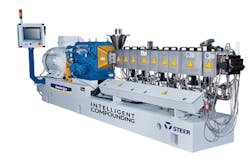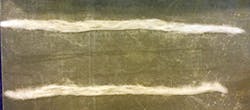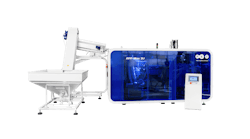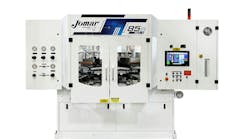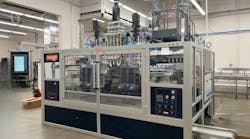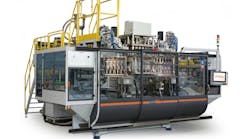Steer America, Uniontown, Ohio, has developed several new commercial compounding applications, based on innovations of its screws and mixing elements. All of the new applications have been developed on Steer's Omega series of co-rotating twin-screw extruders.
According to Robert Roden, associate VP and head of global continuous manufacturing for parent company Steer Engineering Pvt. Ltd., Bangalore, India, the most important trends in compounding are centered on elimination of shear and better control of energy input. Traditional two-lobe kneading blocks, which have been in use since the 1950s, produce unwanted pressure peaks that degrade shear-sensitive resins.
To meet these challenges, Steer offers what it calls "intelligent compounding" technology. The company's Omega series of co-rotating twin-screw extruders is available with a 1.71-to-1 ratio of outer diameter to inner diameter, an advantage over the 1.55-to-1 ratio that is commonly used in the compounding industry in the U.S., according to Roden. Roden said the Omega platform offers other benefits. They include its spline design, which allows running high volumes at high torque, plus the availability of a wide range of specialized mixing elements for processing delicate and heat-sensitive materials.
Roden said that Steer has used complex modeling and algorithms to develop fractional-geometry mixing elements that, compared to prior technologies, give better control of shear and energy input for task-specific applications, especially with delicate materials such as organic pigments, long glass fiber, carbon fiber and natural fibers such as jute.
In a related development, Steer has designed screw elements that provide mixing while performing other tasks such as conveying or metering. All elements designed by Steer are fully intermeshing and self-wiping to prevent stagnation and degradation.
"You are actually mixing along the entire length of the screw," he said. "We have screws in commercial operation today, that from the feed throat all the way to discharge, we combine conveying and mixing tasks, for very little energy [input] but very high-response mixing."
FOCUS ON HIGH LOADINGS, SENSITIVE MATERIALS
Roden outlined several research initiatives that Steer has undertaken during the last year.
High masterbatch loadings: Roden said that in the last 12 months, Steer has been able to make masterbatches with up to 80 percent titanium dioxide content, about 5 percent greater than is typical in the industry. "We are getting higher loadings of pigments in other masterbatches as well," he added.
Brighter colors, special effects: The elimination of pressure peaks has produced better results with both mica-based pigments and organic pigments.
Mica-based pigments used to create pearlescent effects are very delicate, Roden said, and it's important to maintain the mica structure to maintain good coloration. If the mica platelets are altered during compounding, it changes the appearance in the pigment in the plastic. Shear is the biggest cause of damage to mica, he noted. "With mica, you can stay with low-energy-type mixing," he said. "We eliminate shear that is a result of pressure peaks, and that is beneficial to mica."
Similarly, Roden said elimination of shear has improved the performance of organic pigments. Typical organic filler levels in masterbatch are 15-20 percent. At levels exceeding 20 percent, with conventional mixing technology, organic pigments agglomerate when exposed to severe compression and become very difficult to disperse, Roden said.
Roden said Steer has developed mixing blocks that eliminate the pressure peaks associated with two-lobe mixing blocks. By prewetting the pigments and dispersing them with task-specific mixing elements, he said it is possible to achieve loadings of 40 percent or more in organic pigment masterbatch. "By eliminating pressure peaks, you are eliminating the biggest problems," he said.
Better property retention: Roden said that the Omega series has maintained higher intrinsic viscosity when compounding PET masterbatch. Most masterbatch producers will see intrinsic viscosity drop from 0.8 to 0.3, due to degradation of the polymer, he said. "We have achieved results where we have achieved 0.6, and in some cases, even greater than 0.6 in the final product," he said.
Gentle treatment of bio-composites: Fillers such as soy and rice hulls, jute, hemp and grasses are difficult to feed into an extruder and are especially sensitive to shear and heat. Typically, extruder speeds must be slow to avoid heat and shear; this causes extruders to run at less than their capacity, which adds cost to the end product, Roden said. Also, to avoid damage to bio-based reinforcements, conventional extrusion must not exceed 356 degrees Fahrenheit.
Roden said that Steer has improved performance with bio-composite fillers by eliminating peak shear and reducing mean shear. As a result, bio-composite can be produced at full capacity (1,200 revolutions per minute at 85 percent-plus of torque) with no burning. He also said that process temperatures can exceed 356 degrees Fahrenheit for a short time without burning.
He said that Steer is expanding its bio-composite program. "We are in discussions with bio-composite companies making compostable resin, which is very shear-sensitive," he said.
Continuous-glass-fiber reinforcement: Task-specific mixing elements developed by Steer have reduced fiber breakdown, Roden said. He said the Omega extruder has elements designed specifically for the feeding and mixing of the roving. In the last year, Steer has processed continuous glass-fiber roving in an extruder with fiber length retention of up to 80 percent. "We can even get it through a die and make long-fiber thermoplastic without using the pultrusion process," Roden said.
Glass-reinforced rigid PVC: Steer has compounded glass-filled rigid PVC into pellets, sheet and forms. Roden said Steer is working with a large supplier of glass fiber on continuous-glass-reinforced PVC. "They have said that they believe that this will have improved performance," he said. "One is the direct extrusion of continuous fiber charges for compression molding and continuous extrusion of forms." He said the project for glass-reinforced PVC would be fast-tracked over the next year.
SCREW AND BARREL REPLACEMENT PROGRAM
Roden said Steer also can replace the process section of twin-screw extruders from other suppliers, swapping out the screws and barrels with Steer components. "We will replace barrel for barrel, and reuse as much of the existing extruder as possible," he said. "We will come and look at the machine, and if it is in good enough shape to hold the tolerances of our unique elements, we will do a process section swap out," he said. "This is an attractive way for a company to adopt this new technology, without having to go through a capital expenditure" of acquiring a new extruder.
John DeGaspari, senior correspondent
Contact:
Steer America, 866-984-1800, www.steerworld.com

